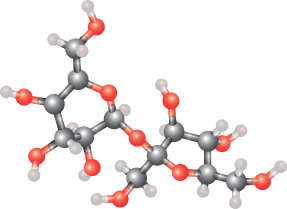Disaccharide

Adisaccharide(also called adouble sugarorbiose)[1]is thesugarformed when twomonosaccharidesare joined byglycosidic linkage.[2]Like monosaccharides, disaccharides are simple sugarssolublein water. Three common examples aresucrose,lactose,andmaltose.
Disaccharides are one of the four chemical groupings ofcarbohydrates(monosaccharides, disaccharides,oligosaccharides,andpolysaccharides). The most common types of disaccharides—sucrose, lactose, and maltose—have 12carbonatoms, with the general formula C12H22O11.The differences in these disaccharides are due toatomic arrangements within the molecule.[3]
The joining of monosaccharides into a double sugar happens by acondensation reaction,which involves the elimination of a water molecule from thefunctional groupsonly. Breaking apart a double sugar into its two monosaccharides is accomplished byhydrolysiswith the help of a type ofenzymecalled adisaccharidase.As building the larger sugar ejects a water molecule, breaking it down consumes a water molecule. These reactions are vital inmetabolism.Each disaccharide is broken down with the help of a corresponding disaccharidase (sucrase,lactase,andmaltase).
Classification[edit]
There are two functionally different classes of disaccharides:
- Reducing disaccharides,in which one monosaccharide, thereducing sugarof the pair, still has a freehemiacetalunit that can perform as a reducingaldehydegroup;lactose,maltoseandcellobioseare examples of reducing disaccharides, each with one hemiacetal unit, the other occupied by theglycosidic bond,which prevents it from acting as areducing agent.They can easily be detected by the Woehlk test or Fearon's test onmethylamine.[4]
- Non-reducing disaccharides,in which the component monosaccharides bond through anacetallinkage between theiranomericcenters. This results in neither monosaccharide being left with a hemiacetal unit that is free to act as a reducing agent.Sucroseandtrehaloseare examples of non-reducing disaccharides because their glycosidic bond is between their respective hemiacetal carbon atoms. The reduced chemical reactivity of the non-reducing sugars, in comparison to reducing sugars, may be an advantage where stability in storage is important.[5][6]
Formation[edit]
The formation of a disaccharide molecule from twomonosaccharidemolecules proceeds by displacing ahydroxy groupfrom one molecule and ahydrogen nucleus(aproton) from the other, so that the new vacant bonds on the monosaccharides join the twomonomerstogether. Because of the removal of the water molecule from the product, the term of convenience for such a process is "dehydration reaction"(also"condensation reaction"or"dehydration synthesis"). For example, milk sugar (lactose) is a disaccharide made by condensation of one molecule of each of the monosaccharidesglucoseandgalactose,whereas the disaccharide sucrose in sugar cane and sugar beet, is a condensation product of glucose andfructose.Maltose,another common disaccharide, is condensed from two glucose molecules.[7]
The dehydration reaction that bonds monosaccharides into disaccharides (and also bonds monosaccharides into more complexpolysaccharides) forms what are called glycosidic bonds.[8]
Properties[edit]
The glycosidic bond can be formed between any hydroxy group on the component monosaccharide. So, even if both component sugars are the same (e.g., glucose), different bond combinations (regiochemistry) andstereochemistry(alpha-orbeta-) result in disaccharides that arediastereoisomerswith different chemical and physical properties. Depending on the monosaccharide constituents, disaccharides are sometimes crystalline, sometimes water-soluble, and sometimes sweet-tasting and sticky-feeling. Disaccharides can serve asfunctional groupsby forming glycosidic bonds with other organic compounds, formingglycosides.
Assimilation[edit]
Digestion of disaccharides involves breakdown into monosaccharides.
Common disaccharides[edit]
Disaccharide Unit 1 Unit 2 Bond Sucrose(table sugar, cane sugar, beet sugar, or saccharose) Glucose Fructose α(1→2)β Lactose(milk sugar) Galactose Glucose β(1→4) Maltose(malt sugar) Glucose Glucose α(1→4) Trehalose Glucose Glucose α(1→1)α Cellobiose Glucose Glucose β(1→4) Chitobiose Glucosamine Glucosamine β(1→4)
Maltose, cellobiose, and chitobiose arehydrolysisproducts of the polysaccharidesstarch,cellulose,andchitin,respectively.
Less common disaccharides include:[9]
Disaccharide Units Bond Kojibiose Twoglucoses α(1→2)[10] Nigerose Two glucoses α(1→3) Isomaltose Two glucoses α(1→6) β,β-Trehalose Two glucoses β(1→1)β α,β-Trehalose Two glucoses α(1→1)β[11] Sophorose Two glucoses β(1→2) Laminaribiose Two glucoses β(1→3) Gentiobiose Two glucoses β(1→6) Trehalulose One glucose and onefructose α(1→1) Turanose One glucose and one fructose α(1→3) Maltulose One glucose and one fructose α(1→4) Leucrose One glucose and one fructose α(1→5) Isomaltulose One glucose and one fructose α(1→6) Gentiobiulose One glucose and one fructose β(1→6) Mannobiose Twomannoses Either α(1→2), α(1→3), α(1→4), or α(1→6) Melibiose Onegalactoseand one glucose α(1→6) Allolactose One galactose and one glucose β(1→6) Melibiulose One galactose and one fructose α(1→6) Lactulose One galactose and one fructose β(1→4) Rutinose Onerhamnoseand one glucose α(1→6) Rutinulose One rhamnose and one fructose β(1→6) Xylobiose Two xylopyranoses β(1→4)
References[edit]
- ^"Biose".Merriam-Webster.
- ^IUPAC,Compendium of Chemical Terminology,2nd ed. (the "Gold Book" ) (1997). Online corrected version: (2006–) "disaccharides".doi:10.1351/goldbook.D01776
- ^Kwan, Lam Peng (2000).Biology- A course for O Level.p. 59.ISBN9810190964.
- ^Ruppersberg, Klaus; Herzog, Stefanie; Kussler, Manfred W.; Parchmann, Ilka (2019)."How to visualize the different lactose content of dairy products by Fearon's test and Woehlk test in classroom experiments and a new approach to the mechanisms and formulae of the mysterious red dyes".Chemistry Teacher International.2(2).doi:10.1515/cti-2019-0008.
- ^"Nomenclature of Carbohydrates (Recommendations 1996): 2-Carb-36".chem.qmul.ac.uk.Archived fromthe originalon 2017-08-26.Retrieved2010-07-21.
- ^"Disaccharides and Oligosaccharides".University of Virginia Faculty and Lab Site.Archived fromthe originalon 2018-11-18.Retrieved2008-01-29.
- ^Whitney, Ellie; Sharon Rady Rolfes (2011). Peggy Williams (ed.).Understanding Nutrition(Twelfth ed.). California: Wadsworth, Cengage Learning. p. 100.ISBN978-0-538-73465-3.
- ^"Glycosidic Link".OChemPal.Utah Valley University. Archived fromthe originalon May 12, 2013.Retrieved11 December2013.
- ^Parrish, F.W.; Hahn, W.B.; Mandels, G.R. (July 1968)."Crypticity of Myrothecium verrucaria Spores to Maltose and Induction of Transport by Maltulose, a Common Maltose Contaminant".J. Bacteriol.96(1). American Society for Microbiology: 227–233.doi:10.1128/JB.96.1.227-233.1968.PMC252277.PMID5690932.
- ^Matsuda, K.; Abe, Y; Fujioka, K (November 1957)."Kojibiose (2-O-alpha-D-Glucopyranosyl-D-Glucose): Isolation and Structure: Chemical Synthesis".Nature.180(4593): 985–6.Bibcode:1957Natur.180..985M.doi:10.1038/180985a0.PMID13483573.
- ^T. Taga; Y. Miwa; Z. Min (1997). "α,β-Trehalose Monohydrate".Acta Crystallogr. C.53(2): 234–236.doi:10.1107/S0108270196012693.
External links[edit]
- Disaccharidesat the U.S. National Library of MedicineMedical Subject Headings(MeSH)
